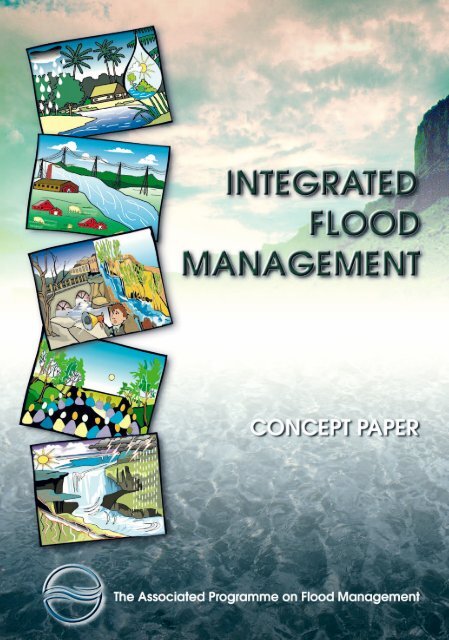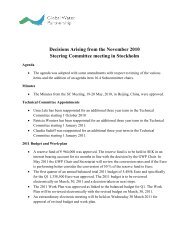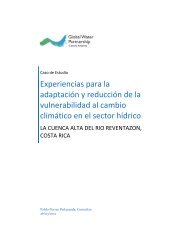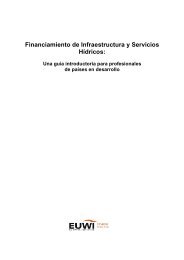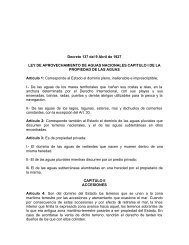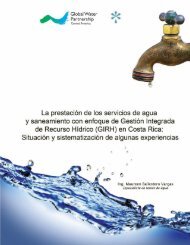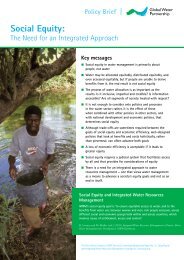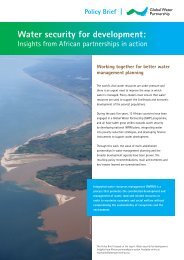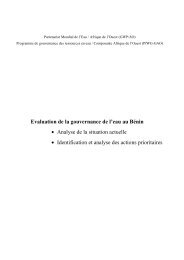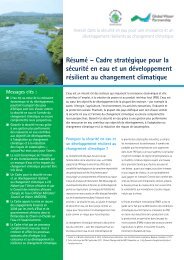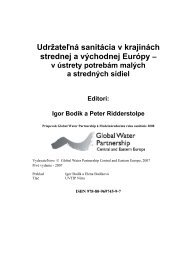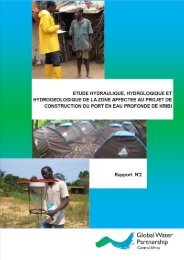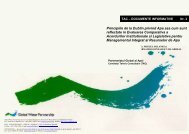Integrated Flood Management. Concept Paper - Cap-Net
Integrated Flood Management. Concept Paper - Cap-Net
Integrated Flood Management. Concept Paper - Cap-Net
Create successful ePaper yourself
Turn your PDF publications into a flip-book with our unique Google optimized e-Paper software.
World Meteorological Organization<br />
Weather • Climate • Water<br />
Global Water Partnership<br />
Edited by<br />
TECHNICAL SUPPORT UNIT<br />
The Associated Programme on <strong>Flood</strong> <strong>Management</strong>
The Associated Programme on <strong>Flood</strong> <strong>Management</strong> (APFM) is a joint<br />
initiative of the World Meteorological Organization and the Global Water<br />
Partnership. It promotes the concept of <strong>Integrated</strong> <strong>Flood</strong> <strong>Management</strong><br />
(IFM) as a new approach to flood management. The programme is financially<br />
supported by the governments of Japan and the <strong>Net</strong>herlands.<br />
The World Meteorological Organization is a Specialized Agency of the<br />
United Nations. It co-ordinates the meteorological and hydrological services<br />
of 185 countries and territories and as such is the centre of<br />
knowledge about weather, climate and water.<br />
The Global Water Partnership is an international network open to all<br />
organizations involved in water resources management. It was created in<br />
1996 to foster <strong>Integrated</strong> Water Resources <strong>Management</strong> (IWRM).<br />
ACKNOWLEDGEMENTS<br />
This concept paper draws much information from contributions made by<br />
Colin Green, Clare Johnson and Edmund Penning-Rowsell, of the <strong>Flood</strong><br />
Hazard Research Centre (FHRC) at the University of Middlesex, U.K., at<br />
the request of the WMO/GWP Associated Programme on <strong>Flood</strong><br />
<strong>Management</strong>. It has been enriched through contributions and comments<br />
made by participants at the Session on <strong>Integrated</strong> <strong>Flood</strong> <strong>Management</strong><br />
held during the Third World Water Forum in March 2003 in Kyoto,<br />
members of WMO’s Commission for Hydrology (CHy) and other experts.<br />
APFM Technical Document No. 1, second edition<br />
© The Associated Programme on <strong>Flood</strong> <strong>Management</strong>, 2004<br />
2
CONTENTS<br />
Summary 4<br />
1. Introduction 6<br />
2. <strong>Flood</strong>s and the Development Process 7<br />
3. Traditional <strong>Flood</strong> <strong>Management</strong> Options 9<br />
4. The Challenges of <strong>Flood</strong> <strong>Management</strong> 11<br />
5. <strong>Integrated</strong> <strong>Flood</strong> <strong>Management</strong> — The <strong>Concept</strong> 16<br />
6. Putting <strong>Integrated</strong> <strong>Flood</strong> <strong>Management</strong> into Practice 24<br />
7. End-note 27<br />
Further Reading 28<br />
3
SUMMARY<br />
Settling on flood plains has enormous advantages, as is evident<br />
from the very high densities of human settlement in, for example,<br />
the <strong>Net</strong>herlands and Bangladesh. Disaster mitigation by restricting<br />
the occupation of flood plains and wetlands limits the potential of these<br />
lands for socio-economic development.<br />
<strong>Integrated</strong> <strong>Flood</strong> <strong>Management</strong> (IFM) integrates land and water resources<br />
development in a river basin, within the context of <strong>Integrated</strong> Water<br />
Resources <strong>Management</strong> (IWRM), with a view to maximizing the efficient<br />
use of flood plains and minimizing loss to life. Thus, occasional flood<br />
losses can be accepted in favour of a long-term increase in the efficient<br />
use of flood plains.<br />
<strong>Integrated</strong> Water Resources <strong>Management</strong>, which, as defined by the<br />
Global Water Partnership (GWP), is “a process which promotes the coordinated<br />
management and development of water, land and related<br />
resources, in order to maximize the resultant economic and social welfare<br />
in an equitable manner without compromising the sustainability of vital<br />
ecosystems”, is based on the recognition that a single intervention has<br />
implications for the system as a whole. More positively, integrating<br />
management means multiple benefits may be achieved from a single<br />
intervention.<br />
For flood management to be carried out within the context of IWRM, river<br />
basins should be considered as integrated systems. Socio-economic<br />
activities, land-use patterns, hydro-morphological processes, etc., need<br />
to be recognized as constituent parts of these systems. A consistent<br />
approach needs to be applied to all forms of possible intervention. The<br />
entire hydrological cycle is considered rather than differentiating between<br />
floods and droughts when planning water resources development.<br />
The aim of IFM is to put in place well-functioning integrated measures for<br />
flood management. For this, the linkages between various relevant<br />
sectors become very important. Thus, the most important key will be cooperation<br />
and co-ordination across institutional boundaries, noting that<br />
the mandates of many institutions will either cover only part of the river<br />
basin or extend well beyond the basin boundary. At the core of integration<br />
is effective communication across institutional and disciplinary<br />
boundaries, which can take place only if there is a perception of common<br />
interest. Emphasis should be on the adoption of flexible strategies<br />
tailored to each flood-prone region (characterized by their various physical,<br />
social, cultural and economic aspects) – recognizing the importance<br />
of evaluating differing options and their relative advantages and disadvantages.<br />
4
<strong>Integrated</strong> <strong>Flood</strong> <strong>Management</strong>—<strong>Concept</strong> <strong>Paper</strong><br />
A participatory and transparent approach which includes a representative<br />
range of stakeholders in the decision making process is another key<br />
component of IFM. The degree of public participation can differ from<br />
region to region. However, it should not be assumed that such stakeholder<br />
involvement will necessarily result in a consensus. Therefore, a<br />
methodology for managing conflicts, possibly a formal system of conflict<br />
resolution, needs to be developed. In this context, a major challenge will<br />
be how to develop a consensus on the question of funding of overall<br />
activities when flood management is one of the main objectives, and to<br />
do this through dialogue among stakeholders – particularly in places<br />
where such practices are not commonplace.<br />
5
1. INTRODUCTION<br />
The recurrence of extreme precipitation anomalies, leading to the<br />
availability of too much or too little water – resulting in floods or<br />
droughts respectively – is a normal component of natural climate<br />
variability and often has far-reaching socio-economic and environmental<br />
implications. The adverse impacts of floods and droughts include loss of<br />
life and property; mass migration of people and animals; environmental<br />
degradation; and shortage of food, energy, water and other basic needs.<br />
The degree of vulnerability to such natural disasters has been highest in<br />
developing countries, where, often it is the poor who suffer the most as<br />
sheer necessity forces them to occupy the most vulnerable areas.<br />
The Plan of Implementation of the World Summit on Sustainable<br />
Development (WSSD), held in Johannesburg in August/September 2002,<br />
highlights the need to “... mitigate the effects of drought and floods through<br />
such measures as improved use of climate and weather information and<br />
forecasts, early warning systems, land and natural resource management,<br />
agricultural practices and ecosystem conservation in order to reverse<br />
current trends and minimize degradation of land and water resources …”<br />
The international community has therefore committed itself to an integrated<br />
and inclusive approach to addressing vulnerability and risk management<br />
that includes prevention, mitigation, preparedness, response and recovery.<br />
Sustainable development through <strong>Integrated</strong> Water Resources<br />
<strong>Management</strong> (IWRM) aims at the sustained improvement in the living<br />
conditions of all citizens in an environment characterized by equity, security<br />
and freedom of choice. It necessitates the integration of natural and<br />
human systems as well as land and water management. The available<br />
literature on IWRM, however, generally does not address the issues<br />
related to flood management aspects of water resources. There is clearly<br />
a need to develop understanding on dealing with this aspect.<br />
This paper conceptualizes IFM as a subset of IWRM and describes the<br />
interplay between floods and the development process. It takes a look at<br />
traditional flood management options from the IFM angle and identifies the<br />
major challenges encountered by flood plain managers and decision<br />
makers before describing the basic tenets and requirements of IFM. The<br />
concept paper is to be followed by a series of supplementary papers going<br />
into further detail about different aspects of IFM to help flood managers<br />
and decision makers implement the concept. This series of papers requires<br />
familiarity with flood management issues and the concept of IWRM.<br />
6<br />
The application, and sometimes the basic philosophy, of IFM and how<br />
flood issues are addressed depend largely on the nature of the flooding<br />
problem, socio-economic conditions and the level of risk a society is<br />
forced or prepared to take in order to achieve its development objectives.<br />
As such, the practical application of IFM is not universal and needs to be<br />
adapted to specific situations.
2. FLOODS AND THE<br />
DEVELOPMENT PROCESS<br />
Societies, communities and households seek to make the best use<br />
of the natural resources and assets available to them in order to<br />
improve their quality of life. However, they are subject to a variety<br />
of natural and man-made disturbances such as floods and droughts,<br />
economic recessions and civil strife. These disturbances adversely<br />
impact their assets or the multipliers that build their capacity to increase<br />
their incomes. Since not all sections of society have equal opportunities<br />
to improve their quality of life – with respect to access to resources, information<br />
and power to participate in the planning process and<br />
implementation of development policies – these disturbances have varying<br />
effects on different social groups.<br />
Natural disasters cause much misery, especially in developing countries<br />
where low-income economies are greatly stressed by their recurrence.<br />
Statistics show that around 70 per cent of all global disasters are linked<br />
to hydro-meteorological events. <strong>Flood</strong>ing is one of the greatest natural<br />
disasters known to humankind. <strong>Flood</strong> losses reduce the asset base of<br />
households, communities and societies by destroying standing crops,<br />
dwellings, infrastructure, machinery and buildings. In some cases, the<br />
effect of flooding is dramatic, not only at the individual household level<br />
but on the nation as a whole. The 1982 floods in Bolivia are reported to<br />
have resulted in a loss equivalent to 19.8 per cent of the country’s GDP.<br />
It may, however, be argued that looking at the impact of floods on a<br />
piecemeal basis, rather than making holistic appraisals, has too narrowly<br />
assessed their impact.<br />
Although living on a flood plain exposes its occupants to one set of<br />
disturbance – i.e. flooding – it also offers enormous advantages. The<br />
deep, fertile alluvial soil of flood plains – the result of aeons of flooding –<br />
is ideal for higher crop yields and helps reduce vulnerability of the flood<br />
plain occupant to a wide range of other disturbances. In turn, flood plains<br />
typically support very high densities of human settlement. It is not entirely<br />
coincidental that the population densities of the <strong>Net</strong>herlands and<br />
Bangladesh are so high, and that the gross domestic product (GDP) per<br />
square kilometre is high in countries whose territories are comprised<br />
mostly of flood plains, such as in the <strong>Net</strong>herlands – which has the highest<br />
GDP per square kilometre in Europe.<br />
It is vital to understand the interplay between floods, the development<br />
process and poverty in order to ascertain the way in which current and<br />
future development planning and implementation leads to, or has the<br />
potential to, increase vulnerability and risk. A population might be poor<br />
because it is exposed to flooding or it might be exposed to flooding<br />
because it is poor and occupies the most vulnerable land. The appropriate<br />
7
<strong>Integrated</strong> <strong>Flood</strong> <strong>Management</strong>—<strong>Concept</strong> <strong>Paper</strong><br />
method of intervention will differ according to which diagnosis is correct.<br />
Further, a community with a weak asset base and few multipliers is<br />
exposed to many different disturbances, some of which may have a greater<br />
impact than floods. Decision makers and development planners at all<br />
levels need to be sensitive to this aspect.<br />
The “vulnerability” of potential victims of flood losses is a function of their<br />
ability to mobilize the assets available to them to meet the challenge<br />
posed by the flood risk versus the extent of the challenge. More generally,<br />
the capacity of the society to maintain or improve its quality of life in<br />
the face of such external disturbances may be enhanced either by reducing<br />
the extent of the challenge presented by the disturbance or by<br />
enhancing their capacity to cope with the disturbance.<br />
8
3. TRADITIONAL FLOOD<br />
MANAGEMENT OPTIONS<br />
Traditionally, flood management has essentially been problem driven:<br />
usually after a severe flood a project would be quickly implemented;<br />
the problem and its solution seeming self-evident without giving any<br />
thought to the impact such solutions would have on upstream and downstream<br />
areas. Thus, flood management practices have largely focused on<br />
reducing flooding and reducing the susceptibility to flood damage<br />
through a variety of interventions. There are a number of different ways to<br />
categorize such flood management interventions. They can be structural<br />
and non-structural; physical and institutional; implemented before, during<br />
and after the flood; etc., and these categorizations overlap.<br />
The flood management interventions listed below are not discussed in<br />
detail. Only the relevant measures that strengthen the case for adopting<br />
an integrated approach to flood management have been elaborated.<br />
• Source control to reduce runoff (e.g. permeable pavements,<br />
afforestation);<br />
• Storing runoff (e.g. detention basins, wetlands, reservoirs);<br />
• Increasing the capacity of the river (e.g. bypass channels, channel<br />
deepening or widening);<br />
• Separating the river and the population (e.g. land use control, dikes,<br />
flood-proofing, house raising);<br />
• Emergency management during the flood (e.g. flood warnings, emergency<br />
works to raise or strengthen dikes, flood-proofing,<br />
evacuation);<br />
• <strong>Flood</strong> recovery (counselling, compensation or insurance).<br />
Source control takes the form of storage in the soil or via the soil and<br />
involves intervention in the process of the formation of runoff from rainfall.<br />
It is normally considered with its consequential impact on the erosion<br />
process, the time of concentration and evapo-transpiration. In assessing<br />
the likely effectiveness of source control, pre-flood conditions (e.g. frozen<br />
or saturated ground) need to be considered. Thus, a potential drawback<br />
with some forms of source control, and other forms of land use modification<br />
such as afforestation, is that their capacity to absorb or store<br />
rainfall depends on the antecedent conditions of the catchment.<br />
In the traditional approach to decreasing the challenge presented by the<br />
flood, an attempt is made to modify the flood to make it easier to cope<br />
with: slow rising, with a long time to peak, and with a low peak level.<br />
Surface water storage, by way of dams and detention basins, is usually<br />
adopted to attenuate flood peaks. More often than not, such storage<br />
serves multiple purposes and the exclusive flood storage can be the first<br />
casualty in any conflict situation. Moreover, by completely eliminating the<br />
9
<strong>Integrated</strong> <strong>Flood</strong> <strong>Management</strong>—<strong>Concept</strong> <strong>Paper</strong><br />
low floods such measures give a false sense of security. Storage has to<br />
be used in an appropriate combination with other structural and nonstructural<br />
measures.<br />
Dikes or flood embankments are most likely to be appropriate for flood<br />
plains that are already intensely used. Increasing the carrying capacity of<br />
the rivers, while disturbing its natural morphological regimes, has<br />
impacts on other river uses and has a tendency to shift the problem<br />
spatially and temporally. Deepening of channels may also affect the<br />
groundwater regime in the region.<br />
Land use control is generally adopted where intensified development on<br />
a particular flood plain is undesirable. Providing incentives for development<br />
to be undertaken elsewhere can probably work better than simply<br />
trying to stop development on the flood plain. However, where land is<br />
under development pressure, especially from informal development,<br />
such planning constraints are unlikely to be effective. <strong>Flood</strong>-proofing or<br />
house raising are most likely to be appropriate where development intensities<br />
are low and properties are scattered or where the warning times are<br />
short. In frequently flood prone areas flood-proofing of the infrastructure<br />
and communication links can reduce the debilitating impacts of floods on<br />
the economy.<br />
<strong>Flood</strong> warnings and timely emergency action are complementary to all<br />
forms of intervention. A combination of clear and accurate warning<br />
messages with a high level of community awareness gives the best level<br />
of preparedness for self-reliant action during floods. It is important to put<br />
in place public education programmes for hazard warnings to be<br />
successful in achieving the desired objective of not allowing the hazard<br />
to turn into a disaster. Flash floods present the greatest risk to life.<br />
However, in flash flood prone catchments it is unwise to rely upon a<br />
formal flood warning system as dissemination takes time.<br />
Evacuation is an essential constituent of emergency planning. Depending<br />
upon circumstances, evacuation may be upward (e.g. into a flood refuge<br />
to a higher elevation) or outward. Outward evacuation is generally necessary<br />
where the depths of water are significant, flood velocities are high<br />
and buildings are flimsy (e.g. not masonry or concrete framed). For<br />
outward evacuation to be successful it must be planned in advance and<br />
the population concerned must know what to do in a flood emergency.<br />
To be effective evacuations require active participation of the communities<br />
right from the planning stage.<br />
10
4. THE CHALLENGES OF<br />
FLOOD MANAGEMENT<br />
Securing Livelihoods<br />
Both population and economic growth exert considerable pressure<br />
on the natural resources of a system. Enhanced economic activities<br />
in flood plains, due to increased population pressure and the<br />
construction of infrastructure, further increase the risk of flooding. <strong>Flood</strong><br />
plains provide excellent, technically easy livelihood opportunities in many<br />
cases. In developing countries with primarily agricultural economies, food<br />
security is synonymous with livelihood security. <strong>Flood</strong> plains contribute<br />
substantially to food production and provide nutrition for the people of<br />
these countries. While it can be argued that virtual water trade – and by<br />
inference reduced dependence on flood prone and water scarce areas –<br />
could address the issue of food security, it would not address the issue of<br />
livelihood security. In the competition for access to limited land resources,<br />
it needs to be ensured that the weaker sections of the population who<br />
largely occupy the flood plains do not suffer further by the application of<br />
policy measures and have their livelihood opportunities reduced.<br />
Population growth and the migration of large populations in developing<br />
countries towards unplanned urban settlements in flood plains increase<br />
the vulnerability of the poorest sectors of society to flooding. It is these<br />
sectors of society that also suffer from a lack of health and sanitation<br />
facilities and are thus most vulnerable to disasters and post disaster<br />
consequences. Emphasis needs to be placed on addressing the needs<br />
of these societies.<br />
The Need for a Basin Approach<br />
A river basin is a dynamic system in which there is a series of interactions<br />
between the land and water environment (Figure 1). These interactions<br />
involve not only water but also soil/sediment and pollutants/nutrients. The<br />
system is dynamic over both time and space. The functioning of the river<br />
basin as a whole is governed by the nature and extent of these interchanges.<br />
An increase in economic activities, such as mining, farming and urbanization,<br />
has been responsible for large-scale deforestation, resulting in<br />
larger sediment yields from water catchments. Landslides induced by<br />
natural or human activities in hilly areas increase sediment concentration<br />
in the rivers. The increased sediment concentration disturbs natural river<br />
regimes. While most of the sediment is carried to the sea, a large portion<br />
gets deposited in river channels thus reducing the discharge capacity of<br />
the conveyance system. Over a period of years this sometimes results in<br />
parts of the river becoming raised above the surrounding flood plains.<br />
11
<strong>Integrated</strong> <strong>Flood</strong> <strong>Management</strong>—<strong>Concept</strong> <strong>Paper</strong><br />
Surface runoff<br />
Rain<br />
Land<br />
River<br />
Sea<br />
<strong>Flood</strong><br />
Pollution<br />
Runoff/floodwater<br />
Sediment<br />
Figure 1. Interaction between land and water<br />
Large-scale urbanization in comparatively small catchments accentuates<br />
flood peaks and reduces the time of concentration. This is because land<br />
use surfaces in urbanized basins – made up of roofs, paved streets and<br />
other impervious surfaces – increase overland flow volume and decrease<br />
groundwater recharge and evapo-transpiration. Urban drainage design is,<br />
unfortunately, most often based on the principle of draining water from<br />
urban surfaces as quickly as possible through pipe and channel networks<br />
that increase the peak flow, and reduce the time available for flood<br />
response, in downstream areas. In lowlands and coastal areas, road and<br />
rail embankments and similar infrastructure can obstruct flood flows and<br />
accentuate flood conditions upstream. Similarly, measures to improve<br />
navigation can have drastic impacts on biodiversity as well as affecting the<br />
risk of flooding. These and other competing requirements on flood<br />
managers call for an integrated basin wide approach to flood management.<br />
Absolute Safety from <strong>Flood</strong>ing is a Myth<br />
Absolute protection from flooding is neither technically feasible nor<br />
economically or environmentally viable. Thinking in terms of setting a<br />
design standard of protection is both a trap and a delusion: such a standard<br />
conflicts with the principle of managing all floods and not just some.<br />
12
<strong>Integrated</strong> <strong>Flood</strong> <strong>Management</strong>—<strong>Concept</strong> <strong>Paper</strong><br />
It is also a delusion because estimates of the magnitude of extreme<br />
floods are very inaccurate and, due to climate change, likely to get modified<br />
over time.<br />
A dilemma of sorts exists regarding whether to design interventions to<br />
provide protection from large floods or not. By reducing the losses from<br />
high frequency floods, there could be greater risk of disastrous consequences<br />
when more extreme events take place. It is also necessary to<br />
consider the likelihood of failure in the case of floods below the notional<br />
design standard. Some structural measures such as dikes and bypass<br />
channels, due to long-term disuse or lack of finances, may not be<br />
adequately maintained and can be susceptible to failure in the event of<br />
floods of magnitude lower than the design standard. In addition to estimating<br />
the likelihood of such failures, how they might fail and how such<br />
events are to be managed should also be considered.<br />
Emergency response to a flood event, like any other disaster, depends on<br />
the frequency of the event. Generally, losses from a large flood that<br />
occurs a few years after a major flood are lower than in the first flood as<br />
both institutions and the public are more prepared and apply the lessons<br />
they learnt from the earlier flood.<br />
Ecosystem Approach<br />
Riverine aquatic ecosystems – including rivers, wetlands and estuaries –<br />
provide many benefits to people such as clean drinking water, food,<br />
materials, water purification, flood mitigation and recreational opportunities.<br />
Variability in flow quantity, quality, timing and duration are often<br />
critical for the maintenance of river ecosystems. For example, flooding<br />
events serve to maintain fish spawning areas, help fish migration and<br />
flush debris, sediment and salt. This is particularly so for regions with dry<br />
climates that experience seasonal flooding followed by a period of<br />
drought. Different flood management measures have varying impacts on<br />
the ecosystem and at the same time changes in the ecosystem have<br />
consequential impacts on the flood situation, flood characteristics and<br />
river behaviour.<br />
Some flood management interventions adversely impact riverine ecosystems<br />
by reducing the frequency of flooding of wetlands that develop<br />
around flood plains, which are subject to frequent flooding and owe the<br />
large variety of flaura and fauna to this phenomenon. In these situations<br />
it is desirable to avoid changes in high frequency floods since to do so<br />
would damage the ecosystems that have developed around the existing<br />
flood regime. What is desirable is to reduce extreme floods. Thus a tradeoff<br />
between competing interests in the river basin is required to<br />
determine the magnitude and variability of the flow regime needed within<br />
a basin in order to maximize the benefits to society and maintain a<br />
healthy riverine ecosystem.<br />
13
<strong>Integrated</strong> <strong>Flood</strong> <strong>Management</strong>—<strong>Concept</strong> <strong>Paper</strong><br />
The ecosystem approach is a strategy for the integrated management of<br />
land, water and living resources that promotes conservation and sustainable<br />
use in an equitable way. The <strong>Integrated</strong> <strong>Flood</strong> <strong>Management</strong><br />
approach encompasses the main principles of the ecosystem approach<br />
by considering the entire basin ecosystem as a unit and accounting for<br />
the impacts of economic interventions in the basin as a whole. It also<br />
supports the decentralization of the management process to the lowest<br />
appropriate level. Environmental sustainability of the flood management<br />
options is one of the prerequisites in IFM.<br />
Climate Variability and Change<br />
General circulation models predict that changes to monsoon patterns<br />
with respect to both intensity and duration are likely to occur as a result<br />
of climate change. This could mean increased flash floods and seasonal<br />
floods, but not necessarily uniformly. The effect this would have on the<br />
design standard flood regarding infrastructure depends on the economic<br />
principles that are followed. Increases in the number of storm surges<br />
hitting the land are also likely. Sea levels may rise effecting flooding in<br />
estuarine areas as well as further inland due to re-grading of riverbeds.<br />
<strong>Flood</strong> warnings are an obvious example of a variability based approach:<br />
the problem is to predict what will happen in the future in a certain place<br />
on the basis of what has happened higher up the system. Again, the<br />
probability of a flood frequently changes. Changes in land use across the<br />
basin affect runoff and hence the probability of a flood of a given magnitude.<br />
This effect is most acute in small, urbanized catchments.<br />
14<br />
Changes in the Decision Making Process<br />
In tandem with the above, there are a number of shifts taking place in the<br />
decision making process. From being one-dimensional and focused on<br />
economic efficiency, decision making is increasingly becoming multidimensional<br />
and concerned with resolving multiple, often conflicting,<br />
objectives. The involvement of different stakeholders is considered as<br />
central to making better decisions.<br />
Conventionally, risk of flooding is expressed in terms of the exceedence<br />
probability of a flood of a given magnitude on a particular stretch of river.<br />
In current thinking, emphasis is placed on analyzing the sequence of<br />
events and associated probabilities that result in a flood – based on the<br />
meteorological event itself and the antecedent conditions. For example,<br />
the impact of a rainstorm of a given intensity on a basin may depend on<br />
in which part of the basin it occurs. Equally, the shape of the outflow<br />
hydrograph from a basin can depend on the direction in which the rain<br />
front moves. In this approach, the consequences of one event depend
<strong>Integrated</strong> <strong>Flood</strong> <strong>Management</strong>—<strong>Concept</strong> <strong>Paper</strong><br />
not simply on its magnitude but also on what happened before. For<br />
example, if the soil is already saturated as a result of previous rainfall,<br />
then the proportion of rainfall that runs off the land and goes to swell the<br />
flow in the river is higher than if the soil was only moist. The risk management<br />
approach is increasingly being adopted in the decision making<br />
process.<br />
Risk <strong>Management</strong><br />
Modern society is termed a “risk society”. Uncertainty and risk management<br />
are recognized as defining characteristics of choice rather than<br />
being inconveniences. It is recognized that “risk” is a social construct<br />
resulting from the accumulated or short-term effects of social and<br />
economic processes and defined as the conditions that societies perceive<br />
as troublesome. Thus, risk management is a necessary component of<br />
the development process, essential for achieving sustainable development.<br />
<strong>Flood</strong> risks are related to hydrological uncertainties. Our knowledge<br />
of the present is incomplete and generally we have only a partial understanding<br />
of the nature of the causal processes in operation. The extent of<br />
future changes cannot be predicted with certainty, as these changes may<br />
be random (e.g. climatic variability), systemic (e.g. climate change) or<br />
cyclical (e.g. El Niño). However, hydrological uncertainty is perhaps subordinate<br />
to social, economic and political uncertainties. For example, the<br />
biggest and unpredictable changes are expected to result from population<br />
growth and economic activity.<br />
Balancing development needs and risks is essential. The evidence worldwide<br />
is that people will not, and in certain circumstances cannot,<br />
abandon flood-prone areas – whether they are in the sparsely populated<br />
flood plains of the Mississippi, the mountains of Honduras or in the<br />
densely populated deltaic regions of Bangladesh. There is a need, therefore,<br />
to find ways of making life sustainable in the flood plains – even if<br />
there is considerable risk to life and property. This can be approached<br />
through the integrated management of floods.<br />
15
5. INTEGRATED FLOOD<br />
MANAGEMENT – THE CONCEPT<br />
<strong>Integrated</strong> Water Resources <strong>Management</strong><br />
The principle of <strong>Integrated</strong> Water Resources <strong>Management</strong> has been<br />
the accepted rationale since the Dublin Conference (1992).<br />
Subsequent meetings (e.g. the Ministerial Declaration of The Hague<br />
on Water Security in the 21st Century, 2001) have re-emphasized that<br />
IWRM is a necessary criterion for sustainable development.<br />
According to the Global Water Partnership (GWP): “<strong>Integrated</strong> Water<br />
Resources <strong>Management</strong> is a process which promotes the co-ordinated<br />
development and management of water, land and related resources, in<br />
order to maximize the resultant economic and social welfare in an equitable<br />
manner without compromising the sustainability of vital<br />
ecosystems.” Sustainable and effective management of water resources<br />
demands a holistic approach, linking social and economic development<br />
with the protection of natural ecosystems and appropriate management<br />
links between land and water uses. Therefore, water related disasters<br />
such as floods and droughts, that play an important part in determining<br />
sustainable development, also need to be integrated within water<br />
resources management.<br />
Defining <strong>Integrated</strong> <strong>Flood</strong> <strong>Management</strong><br />
<strong>Integrated</strong> <strong>Flood</strong> <strong>Management</strong> is a process promoting an integrated –<br />
rather than fragmented – approach to flood management. It integrates<br />
land and water resources development in a river basin, within the context<br />
of IWRM, and aims at maximizing the net benefits from flood plains and<br />
minimizing loss to life from flooding.<br />
Globally, both land, particularly arable land, and water resources are<br />
scarce. Most productive arable land is located on flood plains. When<br />
implementing policies to maximize the efficient use of the resources of<br />
the river basin as a whole, efforts should be made to maintain or augment<br />
the productivity of flood plains. On the other hand, economic and human<br />
life losses due to flooding cannot be ignored. Treating floods as problems<br />
in isolation almost necessarily results in a piecemeal, localized approach.<br />
<strong>Integrated</strong> <strong>Flood</strong> <strong>Management</strong> calls for a paradigm shift from the traditional<br />
fragmented approach of flood management.<br />
<strong>Integrated</strong> <strong>Flood</strong> <strong>Management</strong> recognizes the river basin as a dynamic<br />
system in which there are many interactions and fluxes between land and<br />
water bodies. In IFM the starting point is a vision of what the river basin<br />
should be. Incorporating a sustainable livelihood perspective means<br />
16
<strong>Integrated</strong> <strong>Flood</strong> <strong>Management</strong>—<strong>Concept</strong> <strong>Paper</strong><br />
looking for ways of working towards identifying opportunities to enhance<br />
the performance of the system as a whole. The flows of water, sediment<br />
and pollutants from the river into the coastal zone – often taken to extend<br />
dozens of kilometres inland and to cover much of the river basin – can<br />
have significant consequences. As estuaries overlap the river basin and<br />
coastal zone it is important to integrate coastal zone management into<br />
IFM. Figure 2 depicts an IFM model.<br />
The attempt is, therefore, to try to improve the functioning of the river<br />
basin as a whole while recognizing that gains and losses arise from<br />
changes in interactions between the water and land environment and that<br />
there is a need to balance development requirements and flood losses. It<br />
has to be recognized that the objective in IFM is not only to reduce the<br />
losses from floods but also to maximize the efficient use of flood plains –<br />
particularly where land resources are limited. However, while reducing loss<br />
of life should remain the top priority, the objective of flood loss reduction<br />
should be secondary to the overall goal of optimum use of flood plains. In<br />
turn, increases in flood losses can be consistent with an increase in the<br />
efficient use of flood plains in particular and the basin in general.<br />
Elements of <strong>Integrated</strong> <strong>Flood</strong> <strong>Management</strong><br />
The defining characteristic of IFM is integration, expressed<br />
simultaneously in different forms: an appropriate mix of strategies, points<br />
of interventions, types of interventions (i.e. structural or non-structural),<br />
Water<br />
Resources<br />
<strong>Management</strong><br />
<strong>Integrated</strong> <strong>Flood</strong> <strong>Management</strong><br />
Land Use<br />
<strong>Management</strong><br />
Coastal<br />
Zone<br />
<strong>Management</strong><br />
Hazard<br />
<strong>Management</strong><br />
Figure 2. <strong>Integrated</strong> flood management model<br />
17
<strong>Integrated</strong> <strong>Flood</strong> <strong>Management</strong>—<strong>Concept</strong> <strong>Paper</strong><br />
short or long-term, and a participatory and transparent approach to<br />
decision making – particularly in terms of institutional integration and how<br />
decisions are made and implemented within the given institutional<br />
structure.<br />
Therefore, an integrated flood management plan should address the<br />
following five key elements that would seem to follow logically for<br />
managing floods in the context of an IWRM approach:<br />
• Manage the water cycle as a whole;<br />
• Integrate land and water management;<br />
• Adopt a best mix of strategies;<br />
• Ensure a participatory approach;<br />
• Adopt integrated hazard management approaches.<br />
18<br />
Manage the Water Cycle as a Whole<br />
Recognizing that water is a finite and vulnerable resource, differentiation<br />
between water resources management, flood management and drought<br />
management needs to be circumvented. <strong>Flood</strong> management plans need<br />
to be intertwined with drought management through the effective use of<br />
floodwater and/or by maximizing the “positive” aspects of floods. In arid<br />
and semi-arid climates in particular, floods are essentially the water<br />
resource. Whilst for most of the time runoff is essentially the water<br />
resource, it is only at the times of extremes that runoff is a problem. The<br />
positive effects of floodwater should be recognized in national/local<br />
water management plans. Groundwater and floodwater should be<br />
treated as linked resources and the role of flood plain retention capacities<br />
for groundwater recharge should be considered. Alluvial flood plains,<br />
particularly provide opportunities for groundwater storage of the floodwaters.<br />
Possibilities of accelerated artificial recharge, under given<br />
geological conditions need to be explored and utilized. The possibility of<br />
retaining part of the flood flows, as green water should be explored.<br />
However, in considering interventions that will change the runoff regime,<br />
one needs to consider the effects holistically. For example, taking measures<br />
to reduce runoff during the rainy season could be<br />
counter-productive if it also reduces runoff at other times of the year.<br />
Further, there is a need to manage all floods and not just some – e.g. not<br />
just those floods up to some design standard of protection, and in turn<br />
to design for failure. What happens when a flood more extreme than the<br />
design standard flood occurs and how such a flood will be managed<br />
need to be addressed. One needs to clearly identify areas that will have<br />
to be sacrificed for flood storage in such an extreme flood event in order<br />
to protect critical areas.<br />
More positively, integrating management across functions means that we<br />
may achieve multiple benefits. It would mean no more flood alleviation
<strong>Integrated</strong> <strong>Flood</strong> <strong>Management</strong>—<strong>Concept</strong> <strong>Paper</strong><br />
schemes per se, but only interventions, one purpose of which – and<br />
perhaps the primary purpose – would be to change the risk of flooding<br />
and/or its consequences. It would also mean that interventions that serve<br />
several different purposes simultaneously (e.g. to improve water quality<br />
as well as to improve the management of flow variations in the river)<br />
would be favoured. <strong>Integrated</strong> flood management, therefore, envisages<br />
both economies of scope (e.g. from integration across functions) and<br />
economies of scale (e.g. throughout the river basin). Conflicts of interests,<br />
however, need to be addressed in such multi-options interventions.<br />
Integrate Land and Water <strong>Management</strong><br />
Land use planning and water management have to be combined in one<br />
synthesized plan through co-ordination between land management and<br />
water management authorities to achieve consistency in planning. The<br />
rationale for this integration is that the use of land has impacts upon both<br />
water quantity and quality. The three main elements of river basin<br />
management – water quantity, water quality, and the processes of<br />
erosion and deposition – are inherently linked and are the primary<br />
reasons for adopting a river basin-based approach to IFM.<br />
Upstream changes in land use can drastically change the characteristics<br />
of a flood and associated water quality and sediment transport characteristics.<br />
Upstream urbanization can cause an accentuation of flood<br />
peaks and their early occurrence in downstream reaches. Using low lying<br />
depressions that play an important role in flood attenuation for dumping<br />
solid waste may worsen hygienic conditions and increase flood peaks in<br />
downstream reaches during floods. Ignoring these linkages in the past<br />
has lead to failures. These linkages need to be recognized, understood<br />
and accounted for to lead to synergies in improving river basin performance<br />
in several different ways simultaneously. Taking advantage of these<br />
potential synergies will, however, require a wider perspective of the<br />
issues of development of the river basin in its entirety, rather than<br />
attempting to resolve local problems in an isolated manner.<br />
By adopting a functional approach to flood management, a problem<br />
orientation is an almost inevitable consequence. Taking a wider perspective<br />
can allow the situation to be viewed as one of opportunities, of<br />
looking for ways in which the performance of the basin as a whole can<br />
be enhanced.<br />
Adopt a Best Mix of Strategies<br />
Strategies and options generally used in any flood management approach<br />
are given in Table 1. Adoption of a strategy depends critically on the<br />
hydrological and hydraulic characteristics of the river system and the<br />
region. Three linked factors determining which strategy or combination of<br />
19
<strong>Integrated</strong> <strong>Flood</strong> <strong>Management</strong>—<strong>Concept</strong> <strong>Paper</strong><br />
Strategy<br />
Reducing <strong>Flood</strong>ing<br />
Reducing Susceptibility to Damage<br />
Mitigating the Impacts of <strong>Flood</strong>ing<br />
Preserving the Natural Resources<br />
of <strong>Flood</strong> Plains<br />
Options<br />
Dams and reservoirs<br />
Dikes, levees, and flood<br />
embankments<br />
High flow diversions<br />
Catchment management<br />
Channel improvements<br />
<strong>Flood</strong> plain regulation<br />
Development and redevelopment<br />
policies<br />
Design and location of facilities<br />
Housing and building codes<br />
<strong>Flood</strong>-proofing<br />
<strong>Flood</strong> forecasting and warning<br />
Information and education<br />
Disaster preparedness<br />
Post flood recovery<br />
<strong>Flood</strong> insurance<br />
<strong>Flood</strong> plain zoning and regulation<br />
Table 1. Strategies and Options for <strong>Flood</strong> <strong>Management</strong><br />
strategies is likely to be appropriate in a particular river basin are the<br />
climate, the basin characteristics and the socio-economic conditions in<br />
the region. Taken together, they determine the nature of the floods that are<br />
experienced and their consequential effects.<br />
Quite different strategies are likely to be appropriate in different situations<br />
and in different countries. However, the strategies often involve a combination<br />
of complementary options – a layered approach that includes<br />
intervention at several points in the process of flooding. The differences<br />
in the performance of the different options also suggest that adopting a<br />
layered flood management strategy will often be the best strategy.<br />
Further, if we know that we are necessarily uncertain about the future<br />
then it is not logical to seek for optimal solutions since optimality<br />
depends upon knowledge that is complete, precise and accurate.<br />
Instead, we should seek a resilient response that is flexible and can be<br />
adapted to changing conditions. Such a strategy would be multi-faceted<br />
with a mix of options being used to create a layered strategy, appropriate<br />
to the given conditions.<br />
It is important to avoid isolated perspectives and the trap of assuming<br />
that some forms of intervention are necessarily always appropriate and<br />
others are always necessarily bad. Instead, it is necessary to look at the<br />
situation as a whole, compare the available options and select a strategy<br />
20
<strong>Integrated</strong> <strong>Flood</strong> <strong>Management</strong>—<strong>Concept</strong> <strong>Paper</strong><br />
or a combination of strategies that is most appropriate to a particular<br />
situation. While recognizing the merits and demerits of various structural<br />
and non-structural measures, a good combination of both kinds of measures<br />
needs to be evaluated, adopted and implemented. Measures that<br />
create new hazards or shift the problem in time and space, sometimes<br />
merely temporarily, need to be guarded against.<br />
Evidence suggests that a strategy to decrease risks aimed at a reduction<br />
of flooding – through structural measures and flood embankments or<br />
non-structural measures including afforestation – can confer only partial<br />
safety for people inhabiting flood plains. When protection fails, damage<br />
can be manifold due to increased investments made by flood plain users.<br />
For many societies and situations throughout the world, the cost of<br />
reducing the risk – most often through the adoption of high-cost structural<br />
measures or through policies aimed at relocating “at-risk” land use<br />
– is simply too high to be affordable or the side effects of such measures<br />
are too damaging to the environment or in contravention of the development<br />
goals of the society. In such cases the strategy could then be to<br />
reduce vulnerability through disaster preparedness and flood emergency<br />
responses.<br />
Loss of life and property can be avoided if appropriate disaster response<br />
plans supported by reasonably accurate and reliable forecasts are put in<br />
place and are well rehearsed. <strong>Flood</strong>plain zoning regulation maps, which<br />
show the areas at risk of flooding within a given probability, provide the<br />
most advanced warnings of likely hazard and help people to make their<br />
decisions on investment in these areas. <strong>Flood</strong>plain zoning, however, has<br />
its limitations – particularly in developing economies with population<br />
pressures and unplanned developments.<br />
One area that needs to be guarded against, especially after extreme flood<br />
events, is to adopt only long-term interventions. It is important for the<br />
strategy to be successful that the stakeholders, especially those who are<br />
directly affected by the floods, get an immediate reassurance of safety<br />
through short-term measures. Therefore, the need is to include both the<br />
long-term as well as short-term interventions in the overall plan.<br />
Ensure a Participatory Approach<br />
The definition of sustainable development agreed at the Rio Conference<br />
specifies two defining conditions: the involvement of the public at all<br />
levels of decision making and recognition of the role of women.<br />
Identification and Participation of Stakeholders: IFM, like IWRM, should<br />
be based on a participatory approach, involving users, planners and<br />
policy makers at all levels. For the approach to be participatory it needs<br />
to be open, transparent, inclusive and communicative and requires<br />
decentralization of decision making with full public consultation and<br />
21
<strong>Integrated</strong> <strong>Flood</strong> <strong>Management</strong>—<strong>Concept</strong> <strong>Paper</strong><br />
22<br />
involvement of stakeholders in planning and implementation. All the<br />
upstream and downstream stakeholders representing different parts of<br />
the river basin need to be involved. The core of the debate in the stakeholder<br />
consultation process is frequently not what the objectives are but<br />
what they ought to be. Two aspects of this argument are: who has standing<br />
in the decision, what is the legitimacy of their standing, and by what<br />
right are they entitled to be heard; and, secondly, how to ensure that the<br />
powerful do not dominate the debate.<br />
It is essential that a good representative range of stakeholders is involved<br />
in the dialogue/decision making process leading to IFM. The impacts of<br />
flooding and of interventions are often differentially distributed between<br />
members of households and sections of a community. Women are<br />
usually the primary child and health care providers and so commonly<br />
experience a disproportionate share of the burdens of recovering from<br />
floods. They also play a central part in the provision, management and<br />
safeguarding of water, and their special requirements in dealing with<br />
flood situations need to be reflected in the institutional arrangements.<br />
<strong>Integrated</strong> <strong>Flood</strong> <strong>Management</strong> has to keep gender based, religious and<br />
cultural differences in perspective. The participation of minorities/indigenous<br />
people and weaker sections of society needs to be ensured. The<br />
interests of other vulnerable sections of society, such as children and the<br />
elderly need to be specifically addressed while planning and executing<br />
interventions to reduce risks from flooding in the future, during a flood<br />
and its aftermath. The form of participation could vary, depending upon<br />
the social, political and cultural setup of the society. The participation can<br />
also take place through democratically elected representatives and<br />
spokespersons or through the various user groups such as water users<br />
associations, forest user groups etc. As IWRM and the IFM are not<br />
isolated issues, and usually mirror society’s general characteristics and<br />
problems, the adopted model for stakeholder participation will vary with<br />
the specific circumstances.<br />
Bottom-up and Top-down: An extreme “bottom-up” approach risks fragmentation<br />
rather than integration. On the other hand, the lessons from<br />
past attempts at “top-down” approaches clearly indicate that local institutions<br />
and groups tend to spend a great deal of effort subverting the<br />
intentions of the institution supposedly responsible for overall management<br />
of the basin. It is important to make use of the strengths of both the<br />
approaches using an appropriate mix.<br />
Integration of Institutional Synergy: All institutions necessarily have<br />
geographical and functional boundaries. It is necessary to bring all the<br />
sectoral views and interests to the decision making process. All the activities<br />
of local, regional and national development agencies, departments<br />
and ministries working in the field of agriculture, urban development,<br />
watershed development, industries and mines, transport, drinking water<br />
and sanitation, poverty alleviation, health, environment, forestry, fisheries<br />
and all other related fields should be co-ordinated at the highest level.
<strong>Integrated</strong> <strong>Flood</strong> <strong>Management</strong>—<strong>Concept</strong> <strong>Paper</strong><br />
The challenge is to promote co-ordination and co-operation across functional<br />
and administrative boundaries. River basin organizations can<br />
provide an appropriate forum for such co-ordination and integration. The<br />
best examples of such practice are likely to lie in those conditions under<br />
which there has been no choice but to seek to build such coordination<br />
and cooperation between existing institutions.<br />
Adopt <strong>Integrated</strong> Hazard <strong>Management</strong> Approaches<br />
Communities are exposed to various natural and man-made hazards and<br />
risks. A wide range of activities and agencies are involved in the successful<br />
implementation of disaster management strategies. They involve<br />
individuals, families and communities along with a cross-section of civil<br />
society such as research institutions, governments and voluntary organizations.<br />
All these institutions play vital roles in transforming warnings into<br />
preventive action. Members from all sectors, involving different disciplines<br />
must be involved in the process and carry out activities to ensure<br />
the implementation of disaster management plans.<br />
The success of disaster mitigation will be measured from the public<br />
understanding of the adoption of appropriate strategies and their implementation<br />
and preparedness. <strong>Integrated</strong> natural hazard impact mitigation<br />
to address all hazards holistically (“all hazard” emergency planning and<br />
management) is preferable to hazard specific approaches and hence IFM<br />
should be integrated into a wider risk management system. This helps in<br />
structured information exchange and the formation of effective organizational<br />
relationships. The approach has the benefit of improved treatment<br />
of common risks to life, efficient use of resources and personnel and<br />
includes development concerns along with emergency planning, prevention,<br />
recovery and mitigation schemes. It consequently ensures<br />
consistency in approaches to natural hazard management in all relevant<br />
national or local plans.<br />
Early warnings and forecasts are key links to the series of steps required<br />
to reduce the social and economic impact of all natural hazards including<br />
floods. However, to be effective, early warnings of all forms of natural<br />
hazards must emanate from a single officially designated authority with a<br />
legally assigned responsibility.<br />
23
6. PUTTING INTEGRATED FLOOD<br />
MANAGEMENT INTO PRACTICE<br />
As IFM is essentially a subset of IWRM it faces similar challenges,<br />
though perhaps greater since the desire and pressure to bring<br />
short-term benefits following a disastrous flood can overwhelm<br />
attempts at a longer-term integrated approach. <strong>Integrated</strong> <strong>Flood</strong><br />
<strong>Management</strong> requires certain basic inputs and a conducive environment<br />
for its effective implementation. These requirements are a function of the<br />
specific hydro-meteorological and physical conditions of the basin<br />
coupled with cultural and socio-economic interactions and existing<br />
development plans for the location.<br />
Clear and Objective Policies Supported<br />
with Legislation and Regulations<br />
The nature of the flood problem creates a situation of competing claims<br />
and sometimes the need for immediate action in order to fulfil people’s<br />
aspirations, particularly just after a major flood. In such circumstances<br />
integration is the first casualty. Thus, political commitment to IFM principles<br />
and practice is critical. The strategies developed for IFM need to be<br />
translated into specific policies for planning, allocation and management<br />
of resources. Linking flood management with IWRM and thus social and<br />
economic development, providing inter-sectoral linkages and the basis<br />
for stakeholder participation call for a substantial overhaul of policies,<br />
laws and management institutions. Clear and objective policies for the<br />
declared goals of the government, supported with appropriate legislation<br />
and regulations to enable the process of integration, are a prerequisite for<br />
IFM.<br />
<strong>Integrated</strong> <strong>Flood</strong> <strong>Management</strong> seeks both to modify the system and<br />
interactions in order to enhance economic and social welfare while<br />
recognizing that the system is subject to influences both natural, such<br />
as climate variability, and artificial, such as land use. What one expects<br />
to see as a result are approaches that are appropriate to local conditions<br />
within the wider vision of the river basin, matching policies within<br />
the overall framework of national economic, social and environmental<br />
priorities. There is a need to develop and adopt policies that respond to<br />
the long-term needs and address themselves to both extreme and<br />
normal flood events, providing for stakeholder participation in the<br />
process. These policy stipulations have to be supported through an<br />
appropriate legislative framework such as flood plain zoning regulations,<br />
disaster response regulations, etc. Apart from these, to fulfil the<br />
basic enabling environment for IWRM, the principles of water and land<br />
use, water rights and the legitimacy of stakeholders also need to be<br />
defined.<br />
24
<strong>Integrated</strong> <strong>Flood</strong> <strong>Management</strong>—<strong>Concept</strong> <strong>Paper</strong><br />
The flood management sector has seen very few flood related laws legislated,<br />
and more importantly, implemented, especially in developing<br />
countries. In certain countries the indivisibility of river water and riverbed<br />
does not exist. How it affects the flood plain regulation mechanism needs<br />
to be addressed. <strong>Flood</strong> plain zoning and regulation, flood disaster<br />
management legislation, flood plain infrastructure development regulation<br />
need be put in place and require a political commitment for their<br />
effective implementation.<br />
Institutional Structure through Appropriate Linkage<br />
Fragmentation and sharing of responsibilities in a society are inevitable.<br />
Further, an institution has formal and informal rules which govern both<br />
what it can do and, by inference, what it cannot do. These prescriptions<br />
commonly define both the geographical space across which the institution<br />
can operate and also the functions or objectives it can pursue.<br />
Unfortunately, the geographical boundaries of a river basin rarely coincide<br />
with those of the institutions that are involved in the management of<br />
that basin. In the past, rivers have been important barriers so that the<br />
centre line of a river has commonly come to be an important boundary<br />
between political entities. Again, the differences in size between catchments<br />
around the world mean that a river basin is usually unlikely to be<br />
the appropriate size for, say, a water supply company. As a consequence,<br />
the problem in IFM is usually to deliver comprehensive, co-ordinated<br />
management through the co-operation of fragmented institutions.<br />
It is important to attain a mutually beneficial synergy between national<br />
interests, regional prosperity and the people’s well-being through the best<br />
possible use of regions’ natural resources – both land and water – and<br />
human capacity. River basin management is a long-term strategy to<br />
combat the threat of flooding and erosion with the need to preserve<br />
ecosystems. However, care must be taken that integration at a basin level<br />
does not lead to sub-optimization at a wider level. Not only is it necessary<br />
to consider the functioning of river basins, and the livelihood strategies of<br />
households and communities, but also to treat flood management within<br />
the development strategy of the nation or region as a whole. It is, therefore,<br />
vital that there be both upward integration into national policies and<br />
lateral integration between different national and regional policies. At the<br />
same time, the role of local, regional and national authorities in identifying<br />
and addressing development issues and in implementing development<br />
programmes and activities must be explicitly spelled out.<br />
Community Based Institutions<br />
Integration and co-ordination across sectors calls for trade-offs.<br />
Furthermore, the requirement for stakeholder involvement needs institutions<br />
that are community based. The challenge is to find ways of<br />
25
<strong>Integrated</strong> <strong>Flood</strong> <strong>Management</strong>—<strong>Concept</strong> <strong>Paper</strong><br />
co-ordinating and co-operating across institutional boundaries, to achieve<br />
IFM through decisions at the basin level with the complete involvement of<br />
local level institutions and implementation through these institutions.<br />
To incorporate the “bottom-up” approach in the decision making process<br />
existing institutions need to be modified to facilitate community involvement.<br />
The critical issue in IFM is to resolve relationships between<br />
stakeholders, and so a common platform for stakeholders needs to be<br />
developed.<br />
An obvious but dangerous approach to IFM would be to establish new<br />
institutions that would implement flood management by instructing all of<br />
the existing institutions (performing the functions that need to be integrated<br />
if IFM is to be adopted) operating within its geographical area.<br />
Such a simplistic approach to management of water resources is unlikely<br />
to succeed. Given the wide interaction between land use, hydrological<br />
and hydraulic characteristics of the drainage system; a river basin organization<br />
approach to flood management is preferable. This can ensure that<br />
local institutions do not ignore the effect of their actions on the downstream<br />
stakeholders. Existing institutional and community capacity<br />
needs to be enhanced to adjust to the requirements of IFM.<br />
Multi-purpose interventions call for resolving conflicts between various<br />
user groups or stakeholders since it does not necessarily follow that<br />
consensus would always emerge as the best course of action. Given the<br />
uncertainties in the various elements and options constituting a strategy,<br />
solutions can scarcely be optimal. Consensus building and conflict<br />
management mechanisms have to be built in to the system.<br />
26<br />
Information <strong>Management</strong> and Exchange<br />
In order to build consensus the capacities of all stakeholders and institutions<br />
to appreciate and adopt a holistic approach and look beyond their<br />
narrow short-term interests has to be built on their capabilities to understand<br />
and appreciate differing viewpoints in a rationale and objective<br />
manner. If stakeholder involvement is to be real and effective not only<br />
their capacities and capabilities have to be built up, they must be<br />
supported by expert advice and a knowledge base. The community has<br />
to be fully involved in data and information collection and in formulating<br />
and implementing emergency plans and post disaster responses. The<br />
sharing and exchange of data, information, knowledge and experience<br />
among experts and the general public, policy makers and managers,<br />
researchers and voluntary organizations, upstream and downstream<br />
users, all co-basin states and various institutions, in a most transparent<br />
manner is an essential ingredient for consensus building and conflict<br />
management and for the implementation of a chosen strategy. Transboundary<br />
sharing and exchange of flood information is essential for<br />
implementation of flood preparedness plans in downstream regions.
<strong>Integrated</strong> <strong>Flood</strong> <strong>Management</strong>—<strong>Concept</strong> <strong>Paper</strong><br />
Appropriate Economic Instruments<br />
Living on flood plains involves risk, and for this there is a price to pay. The<br />
cost of living on flood plains is borne by flood plain occupiers, by way of<br />
economic losses and reduced opportunities, and taxpayers, through<br />
government funded protection measures and relief and rehabilitation<br />
activities. To what extent this split is acceptable depends on the social<br />
and economic construct of the society. Ideally, the share in the risk<br />
should be commensurate with the gains to the common taxpayer from<br />
the economic activities of the flood plains occupier. To what extent a<br />
government should fund flood mitigation activities and subsidies to flood<br />
insurance can be debated and will largely depend on the socio-economic<br />
policies of the government. The success of the IFM approach will depend<br />
on how these economic instruments are used.<br />
7. END-NOTE<br />
<strong>Integrated</strong> <strong>Flood</strong> <strong>Management</strong> is founded on a broad concept that uses<br />
a combination of policy, regulatory, financial and physical measures<br />
which focus on coping with floods within a framework of IWRM while<br />
recognizing that floods indeed have beneficial impacts and can never be<br />
fully controlled. It may be noted that the paper does not go into detail on<br />
the various building blocks of IWRM including enabling environment, the<br />
cross-sectoral and upstream downstream dialogue, co-operation within<br />
international river basins, institutional and community capacity building,<br />
etc., which are equally important for IFM.<br />
27
FURTHER READING<br />
1. ACC/ISGWR, 1992. The Dublin Statement and the Report of the Conference. WMO, Geneva.<br />
2. Ahmad, Q.K., Biswas, A.K., Rangachari, R. and Sainju, M.M., 2001. Ganges-Brahamputra-<br />
Meghna Region: A Framework for Sustainable Development. University Press Limited, Dhaka,<br />
Bangladesh.<br />
3. Ashley, C. and Carney, D., 1999. Sustainable Livelihoods: Lessons from Early Experience.<br />
Department for International Development, London.<br />
4. Calder, I., 2000. Land Use Impacts on Water Resources. Land-Water Linkages in Rural<br />
Watersheds Electronic Workshop, Background <strong>Paper</strong> No. 1, FAO, Rome.<br />
5. Charveriat, C., 2000. Natural Disasters in Latin America and the Caribbean: An Overview of Risk.<br />
Research Department Working <strong>Paper</strong> #434; Inter-American Development Bank, Washington DC.<br />
6. Comino, M.P., 2001. Democratising Down Under: The Role of the Community in Water Resource<br />
Decision-making in Australia. <strong>Paper</strong> given at the AWRA/IWLRI, University of Dundee International<br />
Speciality Conference, Dundee, Scotland.<br />
7. Francis, J., 2002. Understanding Gender and <strong>Flood</strong>s in the Context of IWRM. Gender and<br />
Water Alliance, Delft, the <strong>Net</strong>herlands.<br />
8. Global Water Partnership, 1998. Water as a Social and Economic Good: How to Put the<br />
Principle into Practice. TAC Background <strong>Paper</strong> No. 2.<br />
9. Global Water Partnership, 1999. The Dublin Principles for Water as Reflected in a Comparative<br />
Assessment of Institutional and Legal Arrangements for <strong>Integrated</strong> Water Resources<br />
<strong>Management</strong>. TAC Background <strong>Paper</strong> No. 3.<br />
10. Global Water Partnership, 2000. <strong>Integrated</strong> Water Resources <strong>Management</strong>. Technical<br />
Background <strong>Paper</strong> No. 4.<br />
11. Green, C.H., 1999. The Economics of <strong>Flood</strong> Plain Use. Himganga 1(3), 4–5.<br />
12. Green, C.H., 2000. The Social Relations of Water. Invited paper given at the international<br />
seminar, “Water, town-and-country planning, and sustainable development”, Paris.<br />
13. Green, C.H., Parker, D.J. and Penning-Rowsell, E.C., 1993. “Designing for Failure” in Merriman,<br />
P.A. and Browitt, C.W.A., (eds.), Natural Disasters: Protecting Vulnerable Communities. Thomas<br />
Telford, London.<br />
14. Green, C.H., Parker, D.J. and Tunstall, S.M., 2000. Assessment of <strong>Flood</strong> Control and<br />
<strong>Management</strong> Options. World Commission on Dams, <strong>Cap</strong>e Town, (http://www/dams.org).<br />
15. International Commission for the Protection of the Rhine, 2001. Action Plan on <strong>Flood</strong> Defence.<br />
(http://www.iksr.org/hw/icpr).<br />
16. Maharaj, N., Athukorala, K., Vargas, M.G. and Richardson, G., 1999. Mainstreaming Gender in<br />
Water Resources <strong>Management</strong>. World Water Vision.<br />
17. Ministerial Declaration of The Hague on Water Security in the 21st Century. 22 March 2001,<br />
(http://thewaterpage.com/hague_declaration.htm).<br />
18. National Commission for Water Resources Development, Government of India, 1999.<br />
19. Newson, M., 1997. Land, Water and Development: Sustainable <strong>Management</strong> of River Basin<br />
Systems. Routledge, London.<br />
20. Robinson, M., 1990. Impact of Improved Land Drainage on River Flow. Report #113, Institute of<br />
Hydrology, Wallingford, U.K.<br />
21. Rogers, P., Lydon, P. and Seckler, D., 1989. Eastern Waters Study: Strategies to Manage <strong>Flood</strong><br />
and Drought in the Ganges-Brahmaputra Basin. USAID, Washington, DC.<br />
22. Schueler, T., 1995. Crafting Better Urban Watershed Protection Plans. Watershed Protection<br />
Techniques 2(2) (http://www.pipeline.com/~mrunoff/).<br />
23. Spence, C. and Bos, E., (eds), 2003. Flow: The Essentials of Environmental Flows. International<br />
Union for the Conservation of Nature (IUCN), Gland, Switzerland and Cambridge, U.K.<br />
24. United Nations Disaster Relief Co-ordinator (UNDR). Disaster Prevention and Mitigation, Vol. 11,<br />
Geneva, 1984.<br />
25. Walters, C.J., 1986. Adaptive <strong>Management</strong> of Renewable Resources. McGraw-Hill, New York.<br />
26. Wang, Scheng; 2002. Resources Oriented Water <strong>Management</strong>: Towards Harmonious Coexistence<br />
between Man and Nature. China Waterpower Press, Beijing.<br />
27. World Commission on Dams, 2000. Dams and Development – A New Framework for Decision-<br />
Making. Earthscan, London.<br />
28. WMO, 1999. Comprehensive Risk Assessment for Natural Hazards. WMO/TD No. 955, Geneva.<br />
28


